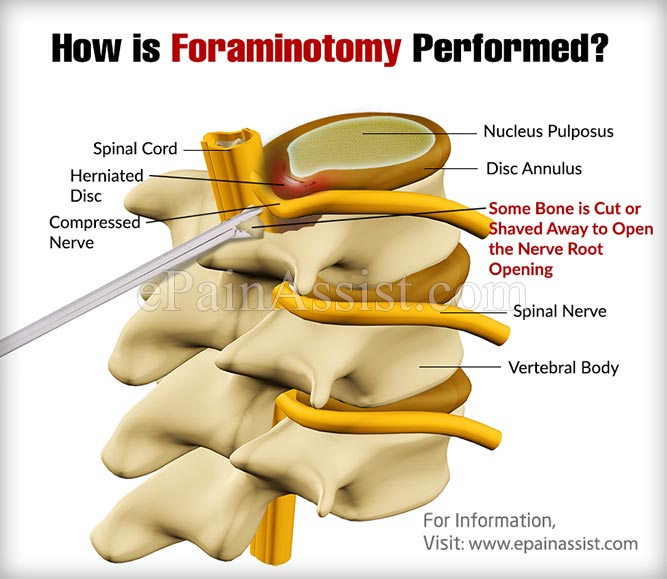What is Foraminotomy?
A foraminotomy is a procedure used to decompress the compressed nerve roots. Foraminotomy is done in cervical spine, thoracic spine, and more commonly in lumbar spine. The term foraminotomy is derived from the medical term for a hollow passageway—foramen. The latter half of the term foraminotomy—otomy—means to open.

Why is Foraminotomy Procedure Performed?
The openings in your spinal column which give passage to the nerve bundle are called the neural foramen. When these openings become narrow, it starts putting pressure on the nerves. This condition is known as foraminal stenosis. The symptoms for this condition include:
- Deep and steady pain in thighs, calf, lower back, shoulder, arms or hands.
- Experiencing pain with certain type of activities or moving your body in a certain way.
- Numbness, weakness, and tingling.
Foraminotomy is found to be very useful in sciatica patients. Sciatic pain is one that is associated with sciatic nerve. The sciatic nerve comes out between L5 and S1 segment. If the foramen is reduced in size because of extra bone growth or disc herniation then this nerve gets compressed and the condition is called sciatica.
When to Opt for Foraminotomy?
The treatment for foraminal narrowing typically begins with conservative methods. These methods may include one or more of the following:
- Rest
- Pain medications
- Physical therapy
- Moderate exercise
- Stretching
- Hot/cold therapy
- Alternative treatments (such as yoga, acupuncture or massage therapy)
If a patient is experiencing pain, but it is not too severe, then typically conservative management is initiated. It must be remembered that the vast proportion of patients will settle with time and as long as improvements are noted at 6 weeks, there is minimal or no weakness, and the pain is not excruciating and is tolerable with oral analgesia, then waiting and continuing with conservative therapy is a good option.
It is important to note that these treatments should only be pursued under the guidance of a physician. This will help to prevent drug interactions and further damage to the spine.
If conservative treatment fails to improve the symptoms of the patients only then is foraminotomy procedure considered.
Procedure: How is Foraminotomy Performed?
Foraminotomy is a minimally invasive procedure. It can be performed at any level of the spine. Foraminotomy is performed under general anesthesia. During the foraminotomy surgery, you lie face down on the operating table. A cut (incision) is made in the middle of the back of your spine. The length of the incision depends on how much of your spinal column will be operated on. Skin, muscles, and ligaments are moved to the side. Your surgeon may use a surgical microscope to see inside your back. Some bone is cut or shaved away to open the nerve root opening (foramen). Any disk fragments are removed. Other bone may also be removed at the back of the vertebrae to make more room (laminotomy or laminectomy). The surgeon may do a spinal fusion to make sure your spinal column is stable after surgery. The muscles and other tissues are put back in place. The skin is sewn together.
Endoscopic foraminotomy surgery takes a minimally invasive approach to relieve pressure in the foramen caused by compression. Spinal bone spurs, herniated disc material, scar tissue, or excessive ligament development is removed to free the trapped nerve.
What are the Risks of a Foraminotomy?
Foraminotomy is successful in most people with minimal risk of complications. Here are some possible complications:
- Infection
- Nerve damage
- Stroke
- Complication from anesthesia
- Damage to the spinal cord
- Excess blood loss
Beside these complications, there is a slight risk that the foraminotomy surgery will not relieve your pain. The risk of complications arising out of foraminotomy surgery varies from person to person depending on various things like age, anatomical location of the surgery in the spine, medical condition of the patient etc.
Recovery: After the Foraminotomy
Within a couple of hours after foraminotomy, you should be able to sit up in bed. Pain can be controlled by taking pain medications. You should be able to eat a normal diet.
You should be able to go home in a day or two following foraminotomy procedure. You must make sure to follow the doctor’s instructions about wound care, physical activity, and medications. Some people might need physical therapy after foraminotomy procedure. You should be able to do light work after a few weeks.
Your doctor can give you an idea about what to expect after the foraminotomy surgery. You must keep all the follow-up appointments and must discuss with your doctor about any new or worsening symptoms following foraminotomy procedure.
Overall, 80-90% of patients obtain a significant benefit from foraminotomy surgery, and this is usually maintained in the long term.
Endoscopic Foraminotomy procedures offer quick recovery options, allowing patients to be back at work and normal activities much more quickly. Foraminotomy is a very common operation with high success rates. It is an excellent option for the proper candidates. Since it is not a fusion method, there is no insertion of bone grafts or an artificial disc device. Foraminotomy can be performed as an outpatient surgery.
In conclusion, if you are experiencing severe and limiting neck or back pain, and your physician believes you are a good candidate for foraminotomy, this is a very good option for you since foraminotomy has a very good success rate and is a minimally invasive procedure.
